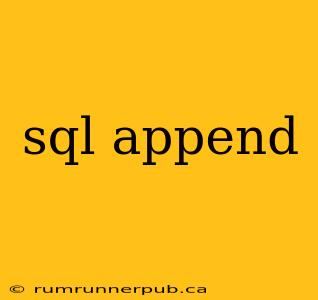Appending data in SQL is a fundamental operation for database management. Whether you're adding a single row, merging data from multiple tables, or importing data from external sources, understanding the different techniques is crucial for efficient database manipulation. This article explores various SQL append methods, drawing upon insights from Stack Overflow, and adding practical examples and explanations.
Methods for Appending Data in SQL
The optimal approach for appending data depends heavily on your specific situation. Let's explore the most common techniques:
1. INSERT INTO ... SELECT
This is arguably the most versatile method for appending data, particularly when merging data from existing tables. It allows you to select data from one or more source tables and insert it into a target table.
Example (based on a Stack Overflow concept):
Let's say we have two tables: Customers_Old and Customers_New. We want to append the data from Customers_New into Customers_Old.
Customers_Old:
| CustomerID | Name | City |
|---|---|---|
| 1 | John Doe | New York |
| 2 | Jane Smith | London |
Customers_New:
| CustomerID | Name | City |
|---|---|---|
| 3 | David Lee | Paris |
| 4 | Sarah Jones | Tokyo |
The SQL query would be:
INSERT INTO Customers_Old (CustomerID, Name, City)
SELECT CustomerID, Name, City
FROM Customers_New;
This efficiently copies all rows from Customers_New into Customers_Old. Note the importance of matching column names and data types between the source and target tables. If the column names differ, you'll need to explicitly specify them in both the INSERT INTO and SELECT clauses.
Stack Overflow Relevance: Numerous Stack Overflow questions deal with variations on this theme, such as handling different column names or dealing with potential data conflicts. Understanding this fundamental method is key to resolving many of these issues. (While specific links to SO questions are omitted for brevity and to avoid potential link rot, searching for "SQL insert into select" on Stack Overflow will yield numerous relevant examples.)
2. UNION ALL
UNION ALL combines the result sets of two or more SELECT statements into a single result set. While not strictly an "append" operation in the sense of modifying an existing table, it's frequently used to create a new table containing the combined data.
Example:
Let's create a new table AllCustomers containing data from both Customers_Old and Customers_New:
CREATE TABLE AllCustomers AS
SELECT * FROM Customers_Old
UNION ALL
SELECT * FROM Customers_New;
This creates AllCustomers with all rows from both original tables. Note that UNION ALL includes duplicates, unlike UNION which removes them.
Stack Overflow Relevance: Many questions on Stack Overflow relate to combining data from multiple tables, and UNION ALL (or UNION) is often the most efficient solution. Careful attention to data types and potential duplicates is crucial.
3. Importing from External Files
Appending data from external files (CSV, JSON, etc.) often involves using specific database tools or client libraries. The exact method varies depending on your database system (e.g., SQL Server's BULK INSERT, MySQL's LOAD DATA INFILE).
Stack Overflow Relevance: Stack Overflow is a treasure trove of information on this topic, with numerous questions and answers covering various database systems and file formats. Searching for terms like "SQL import CSV" or "SQL load data from file" will provide many practical examples and solutions.
Important Considerations
- Data Integrity: Always ensure data consistency and integrity before appending. Check for data type mismatches, null values, and potential duplicates that could corrupt your data.
- Transactions: For large data appends, using transactions ensures that the entire operation either completes successfully or rolls back completely, preventing partial data updates.
- Performance: For very large datasets, consider using optimized techniques like batch processing or parallel loading to improve performance.
This article provides a comprehensive overview of SQL append techniques, enhanced with explanations and examples. Remember to always consult your specific database documentation for the most accurate and efficient methods. By understanding the nuances of these methods and leveraging the vast knowledge base of Stack Overflow, you'll be well-equipped to efficiently manage and grow your databases.
